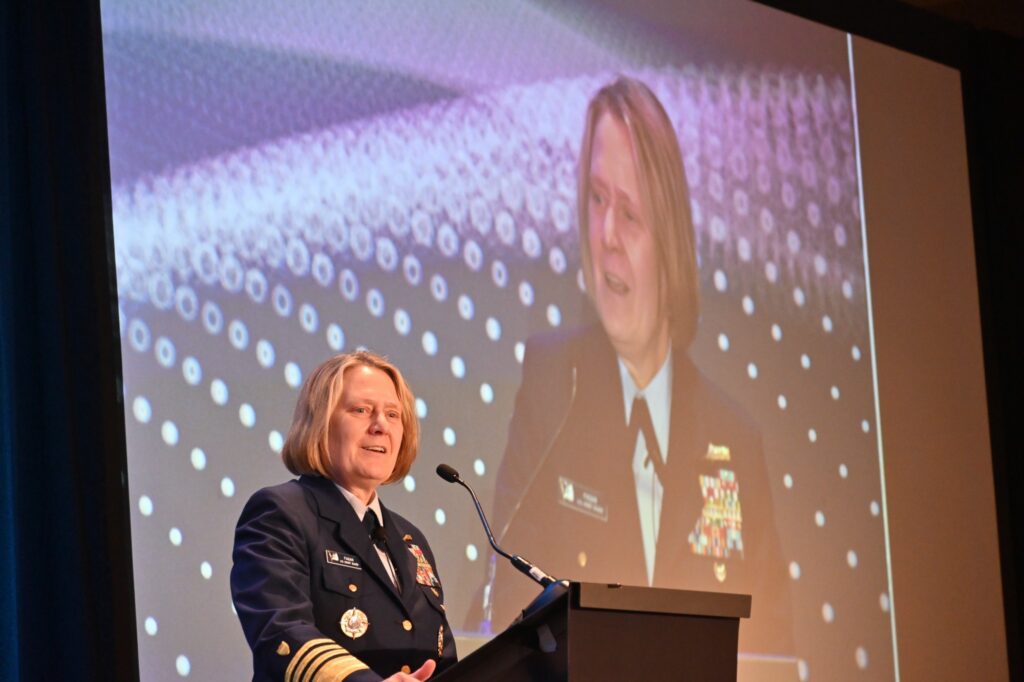
ARLINGTON, Virginia — The U.S. Navy will soon conduct a promised demonstration of a system to rearm ships while still at sea, Secretary of the Navy Carlos Del Toro announced June 10 at the Surface Navy Associations’ national symposium.
“Last year here at SNA, I announced that we would conduct an at-sea demonstration of ‘rearm at sea’ using the transportable rearming mechanism, called TRAM, at Port Hueneme. In this critical decade, the near-term deterrent effect of fielding TRAM in the fleet cannot be overstated,” Del Toro said.
In the year since, he said the funding was procured and preparations are being finalized for the test, “which I have directed to take place no later than this coming summer,” he said.
TRAM is designed to allow the rapid reloading of Vertical Launching System cells in up to sea state 5 — waves of eight to 13 feet — using the fleet’s existing interfaces. “This capability will herald nothing short of a revolution in naval surface warfare logistics,” he said.
“As TRAM delivers an at-sea reload missile capability to the fleet, we look forward to working with industry to improve our missile supply through efforts like the Naval Modular Missile program as well,” he said. “That program will use common components across the family of naval missiles, increasing our efficiency and resilience in manufacturing.”
The sea services are coping with aging equipment and facilities, sub-par recruitment and surging threats around the world — Del Toro noted the “pacing threat” of China, the ongoing threat of Russia and the newer threats from Iran-backed Houthi rebels in the Red Sea.
He and other speakers said the services are responding to these issues with innovative equipment, such as TRAM, closer ties with international partners and a renewed focus on the warfighter.
“To maintain a global, sustainable maritime posture, we must continue to innovate. Innovate,” Del Toro said. “The company, the enterprise that is not constantly innovating is dying on the grapevine.”
That includes new platforms such as the DDG (X) next-generation destroyer as well as a hybrid fleet that includes unmanned systems, such as have been demonstrated in real-world deployments by Task Force 59.
“Our hybrid fleet is not a distant vision anymore, or a hazy concept outlined on a napkin, uncertain and undefined. The hybrid fleet today is a tangible reality, operational and actively preparing to help dominate the battlespace in every way,” he said.
Navy plans also include strengthening partnerships with other nations, such as the ones who have signed up for Operation Prosperity Guardian to respond to Houthi attacks in the Red Sea.
“We simply cannot do this alone,” Del Toro said. “As history has taught us, the United States of America has flourished because of our many international partners, our friendships … by consistently deploying alongside our allies and partners abroad, we force our adversaries to face a stark reality — that a fight with the American naval forces and the forces of like-minded nations will be costly and ultimately unwinnable.”

Coast Guard Commandant
Coast Guard Commandant Linda Fagan also spoke Jan. 10 and also stressed the value of international partnerships for the Coast Guard as it maintains a strong presence in the Arctic and fights illegal, unreported and unregulated (IUU) fishing.
“In some regards, we’re like many of the world’s navies,” she said of the Coast Guard’s worldwide footprint.
One of those international tasks is the struggle against IUU, where ships from one nation illegally enter the exclusive economic zone of another country to steal fish or other sea life.
“It is a crime, it’s theft of natural resources, it erodes sovereignty, and there are nations who are operating with impunity and stealing from other nations, and the Coast Guard has a role in helping those nations enforce their own sovereignty and create capacity to counter that activity,” she said.
For example, the coast Guard’s fast response cutter Frederick Hatch just completed a 47-day expeditionary patrol to support Operation Blue Pacific, which includes operations with authorities from the Philippines, Palau and Papua New Guinea. The ship’s crew helped those nations take enforcement actions against ships fishing illegally in their waters.
Far from the balmy Pacific, the service also plays a key role in supporting shipping in the Arctic and Antarctica. This is challenging given that the service has only two functioning icebreakers, the heavy icebreaker Polar Star and the medium icebreaker Healy.
The service plans to buy three new polar security cutters to replace the aging Polar Star, which was commissioned in 1976 (Fagan herself served as an ensign on it).
While climate change means there’s less ice for longer periods of time in the Arctic, it’s still there, and “getting a polar security cutter fielded is an absolute top priority for the organization,” she said. “We’re on budget, we’re on contract for the polar security cutter.”
As with the Navy, the Coast Guard struggles with aging equipment (such as the Polar Star) and recruitment numbers that aren’t hitting the target. “The Coast Guard is not unique in our need for people,” she said.
At the beginning of COVID, recruitment went down and has stayed down. The service has invested in recruiters and “we have stopped that descent,” and the talent the Coast Guard is attracting is “bright, they are motivated, they know why they want to serve, they understand the value proposition of the Coast Guard,” she said.
There are ways the Coast Guard can deal with the shortage of personnel, including speeding the decommissioning of aging cutters, as well as making serving on ships more attractive, such as by adding communications services like SpaceX’s Starlink.
Fagan said when she served on the Polar Star, she basically disappeared for four months, calling her parents when the ship pulled into Australia. But recently, while Healy was in the Arctic, the CO was sending her photos of polar bears and walruses in real time.
“These are the kinds of investments that become critical for on-board lifestyles … crews want to be able to talk to their families and not disappear for four months,” she said. “This is the workforce that we’re on-boarding and we need to provide the tools that enable those kinds of engagements and expectations of the force.”
Navy Honors ‘Human Tugboat’ by Naming DDG 142 for Hero Charles French
Secretary of the Navy Carlos Del Toro announced Jan. 10 that the Navy’s newest destroyer, DDG 142, will be named after Petty Officer First Class Charles Jackson French, dubbed the “human tugboat” for an act of bravery in World War II.
On Sept. 5, 1942, French’s ship, the USS Gregory, was sunk by the Japanese navy during the battle of Guadalcanal. He gathered 15 injured shipmates and swam through the night to carry them to an island where they would be safe from capture,” defying the odds and the sharks with nothing but his own grit and compassion,” Del Toro said.
He was recommended for the Navy Cross for his actions, but received only a letter of commendation, which Del Toro said is “what I actually give out today for a really good PowerPoint presentation.”
Del Toro said the Navy is finally giving French his due, naming a rescue swimming training pool at Naval Base San Diego for him, and now, “with long overdue recognition,” DDG 142.






